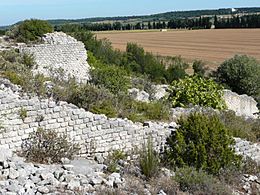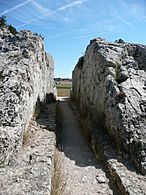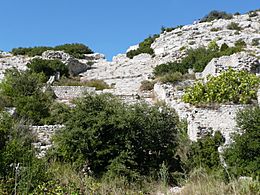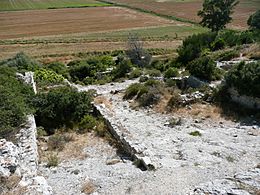Barbegal aqueduct and mills facts for kids
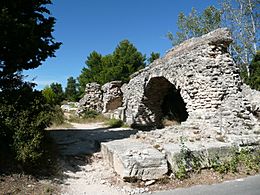
The aqueduct
|
|
| Location | Fontvieille, Bouches-du-Rhône, France |
|---|---|
| Coordinates | 43°42′09″N 4°43′17″E / 43.70250°N 4.72139°E |
The Barbegal aqueduct and mills was a huge set of Roman watermills in southern France. It was located near the town of Arles, in a place called Fontvieille. This amazing complex was once called "the greatest known concentration of mechanical power in the ancient world". Its 16 overshot water wheels made it the biggest ancient mill complex ever found.
Another similar mill complex was found in Rome, on the Janiculum hill. Some historians think that other large Roman cities might have had similar mill systems too.
Contents
What Were the Barbegal Mills?
The Barbegal mills were built about 12 kilometers (7.5 miles) northeast of Arles. This was where the main aqueduct that brought water to Arles reached a very steep hill. The mills were made up of 16 water wheels. These wheels were arranged in two parallel lines, with eight wheels in each line, going down the hillside.
There are still many stone remains of the water channels and the foundations of the individual mills. You can also see a staircase that went up the hill where the mills were built.
How Did the Mills Work?
The mills were used from the early 2nd century AD until about the end of the 3rd century AD. Experts believe the wheels were overshot water wheels. This means water flowed over the top of each wheel, making it turn. The water then flowed out from one wheel and powered the next one down the hill.
The mills could produce about 4.5 tons of flour every day. This was enough to make bread for as many as 10,000 people. At that time, the city of Arles (then called Arelate) had about 30,000 to 40,000 residents.
Water Supply for the Mills
The Roman aqueducts that fed these mills also supplied water to the city of Arles. The two aqueducts joined together just north of the mill complex. A special gate, called a sluice, controlled how much water flowed into the mills. This made sure the mills had enough water to operate.
Roman Water Mill Technology
The Romans knew a lot about vertical water mills. A famous Roman architect named Vitruvius described them in his book De architectura around 25 BC. Pliny the Elder also mentioned them in his Naturalis Historiæ in 77 AD.
Later, there were records of floating water mills in Byzantium. The poet Ausonius even wrote about sawmills on the river Moselle.
Other Uses for Water Wheels
Using many water wheels stacked one after another was common in Roman mines. This was especially true in places like Spain and Wales. It's possible that the Barbegal mills were also used for cutting timber (wood) and stone when they weren't grinding wheat into flour.
For example, the Hierapolis sawmill from the 3rd century AD shows a special saw powered by a crank. Another similar saw has been found at Ephesus. This shows that Romans used water power for more than just grinding grain.
Visiting the Barbegal Site
You can visit the Barbegal site today! You can park where a small road (Route de L’Aqueduc) crosses the large remains of the original aqueduct. Then, you can walk south for about 250 meters (820 feet) along the aqueduct. You'll go through a three-meter-deep (10-foot) rock cut, which leads you to the top of the mill complex.
The site is usually signposted as "Roman aqueduct" instead of "mill." The Arles Museum of Antiquity has a cool model of the mill that helps you understand how it worked. The site can be a bit overgrown, so be careful when exploring the ruins.
Influence on History
The Barbegal aqueduct and mills were very important for showing how Romans used water power. A science historian named James Burke studied Roman watermill technology. He believed that these Roman mills influenced the Cistercian monks who later used a lot of water power. This use of water power by the Cistercians then helped lead to the Industrial Revolution.
See also
 In Spanish: Acueducto y molinos de Barbegal para niños
In Spanish: Acueducto y molinos de Barbegal para niños


